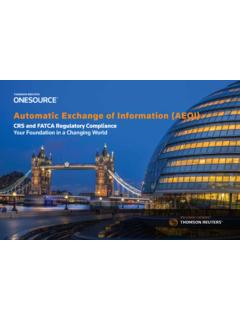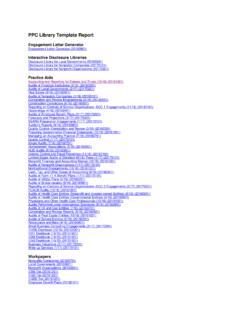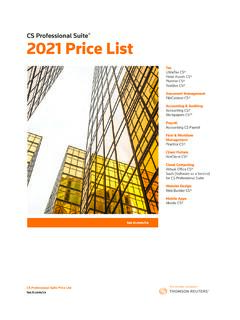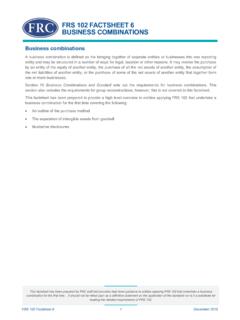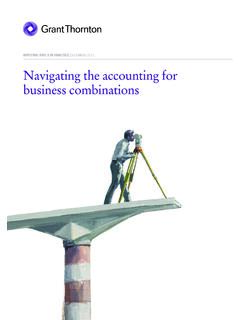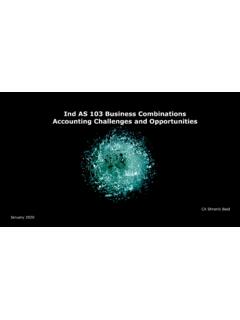Transcription of Accounting and Reporting for Business Combinations
1 SPECIAL REPORTA ccounting and Reporting for Business Combinations2 SPECIAL REPORT: Accounting AND Reporting FOR Business COMBINATIONSM ergers, acquisitions and other types of Business Combinations are a common strategy among companies that wish to grow their businesses or diversify their risk. Entering into Business Combinations can help companies reach new geographic markets, expand product offerings or achieve various synergies. Business Combinations offer a number of benefits to the parties involved, but the initial Accounting for the Business combination can be complicated and often requires extensive time and effort. The authoritative Accounting and Reporting guidance for Business Combinations under US GAAP is included in Topic 805, Business Combinations , of the FASB Accounting Standards Codification. Topic 805 interacts with other various technical areas of the Codification, such as the guidance on consolidation (the concept of control), fair value measurements, income taxes and share-based payments.
2 Thus, a Reporting entity must be familiar with not only Topic 805, but also these other technical areas. In addition, SEC registrants must comply with an additional set of rules and regulations for SEC Reporting purposes, such as the pro forma disclosures requirements in Rule 3-05 of Regulation S-X. One of the challenges that a Reporting entity might face in Accounting for a Business combination is determining if it has acquired a Business or a group of assets. The Accounting treatment is very different based on the result of that determination. Another challenge is identifying all of the assets that were acquired and all of the liabilities that were assumed (including intangible assets and contingencies that the acquired company may not have recorded). Other challenging areas involve measuring the assets acquired and liabilities assumed in the Business combination at fair value and the resulting goodwill, Accounting for adjustments to the initial amounts recorded and determining the tax implications of the acquisition.
3 Many areas of the guidance require management to make judgments and assumptions. In addition, certain aspects of the Accounting are changing, such as the definition of a Business and rules for goodwill impairment testing. A Reporting entity must stay informed about the ever-evolving guidance. 3 SPECIAL REPORT: Accounting AND Reporting FOR Business COMBINATIONSB ackground and ObjectivesA Reporting entity must ensure that the Accounting and Reporting for a Business combination reflect the terms of the transaction at hand. Each Business combination is unique. Even if a Reporting entity has undergone a Business combination before, there will be new or different facts and circumstances to analyze. For instance, some Business Combinations may involve items that require careful attention, such as intangible assets, contingencies, replacement awards or a previously-held equity interest, among others. In addition, the measurement of an item acquired or assumed in the Business combination or transferred as consideration is based generally on fair value.
4 These fair value estimates depend on market participants assumptions about events that have occurred or exist as of the acquisition date. A Reporting entity must ensure that it allocates sufficient resources to understand and address all of the Accounting and Reporting requirements. Many elements of a Business combination require significant management estimates and judgment. A Reporting entity may wish to engage the assistance of various experts throughout the process, such as valuation specialists, tax practitioners and legal advisers. A Reporting entity also must be able to articulate and support the basis for the judgments made and conclusions reached in performing the Accounting . Business Combinations are often examined closely by regulators, investors and other users of financial statements. Users may raise questions to better understand the economic substance of the transaction and regulators may ask a Reporting entity to prove that it has complied with the Accounting and Reporting requirements.
5 A Reporting entity must be prepared to field questions about its treatment of a Business special report focuses on the Accounting required under US GAAP and is laid out in the following sections: Scope The Acquisition Method Determine the acquirer Determine the acquisition date Recognize and measure the assets, liabilities and noncontrolling interest Recognize and measure any goodwill or gain from a bargain purchase Presentation DisclosureEach Business combination is unique. Therefore, the Accounting for each Business combination may be SPECIAL REPORT: Accounting AND Reporting FOR Business COMBINATIONSS copeA Business combination is a transaction in which an acquirer gains control over a determine if a Business combination has happened, an acquirer must first evaluate whether it has acquired a Business or a group of assets. The distinction is critical because the Accounting treatment is very different based on the transaction is not a Business combination unless it involves the acquisition of a Business .
6 Therefore, understanding the FASB s definition of a Business is important in order to determine if the transaction is a Business Business is defined, under US GAAP, as a set of activities and assets that is both self-sustaining and managed to provide a return to investors. A Business generally has three elements: inputs, processes and outputs, but a Business does not have to include outputs. Also, there is no minimum number of inputs or processes required. A set of activities and assets is considered a Business as long as market participants are capable of buying the set and continuing to produce outputs, such as incorporating the set with their own inputs and processes. OBSERVATION: The FASB definition of a Business is not the same as the definition of a Business under SEC regulations. Rule 11-01(d) of SEC Regulation S-X indicates that the term Business : should be evaluated in light of the facts and circumstances involved, and whether there is sufficient continuity of the acquired entity s operations prior to and after the transactions so that disclosure of prior financial information is material to an understanding of future operations.
7 A presumption exists that a separate entity, a subsidiary or a division is a Business . The SEC definition must be used to determine whether Reporting under Item , Completion of Acquisition or Disposition of Assets, of Form 8-K is required for an acquisition transaction. In other words, a Reporting entity might have to provide historical or pro forma financial information under Regulation S-X if an SEC registrant determines that a significant Business acquisition has occurred or is probable, even if the transaction is not a Business combination under US : In January 2017, the FASB issued Accounting Standards Update (ASU) No. 2017-01, Business Combinations (Topic 805): Clarifying the Definition of a Business . This ASU is effective for public Business entities for annual periods beginning after December 15, 2017 (and interim periods therein) and for all other entities for annual periods beginning after December 15, 2018 (and interim periods after the year of adoption).
8 ASU No. 2017-01 revises the definition of a Business under US GAAP by requiring a Business to have, at a minimum, an input and a substantive process that together contribute to the ability to create outputs. This ASU is intended to help entities distinguish between transactions that are Business Combinations and those that are asset acquisitions. In general, fewer sets of activities and assets will meet the revised definition of a Business . Therefore, some of today s transactions may not qualify as a Business combination under the new definition. ASU No. 2017-01 revises the definition of a Business , which may change whether a transaction is a Business REPORT: Accounting AND Reporting FOR Business Combinations 5 ASU No. 2017-01 provides an initial screen to evaluate if a set of activities and assets is a Business . The following decision tree illustrates the initial screen. Is substantially all of the fair value of the gross assets acquired (or disposed of) concentrated in a single identifiable asset (or group of similar identifiable assets)?
9 The set does not constitute a Business and no further analysis is entity must determine if the set includes, at a minimum, an input and a substantive process that collectively contribute to the ability to create outputs**A market participant is not required to evaluate whether it could replace any missing No. 2017-01 provides a framework to determine if a transaction includes an input and a substantive process. In addition, it gives a more narrow definition of the term output to better align with the guidance in Topic 606, Revenue from Contracts with Customers. ASU No. 2017-01 must be applied prospectively. Early application is allowed for transactions that have not been reported in financial statements issued or made available for issuance. The following table gives an example of how ASU No. 2017-01 might change an entity s conclusion of whether a set of activities and assets is a to ASU No. 2017-01 Under ASU No.
10 2017-01A real estate entity sells a building with existing leases. The sale involves the transfer of inputs, but not transaction might meet the definition of a Business under current GAAP because the buyer can take the input (the building) and combine the input with its own processes to produce outputs (lease income).The transaction does not meet the definition of a Business under ASU No. 2017-01 because there is no substantive process SPECIAL REPORT: Accounting AND Reporting FOR Business COMBINATIONSIf an entity acquires assets and liabilities that do not meet the definition of a Business , the transaction is not a Business combination . Instead, the entity accounts for the transaction as an asset acquisition under Subtopic 805-50, Business Combinations Related Issues. OBSERVATION: Understanding the definition of a Business is critical to ensure that an entity properly identifies transactions as either Business Combinations or asset acquisitions.



